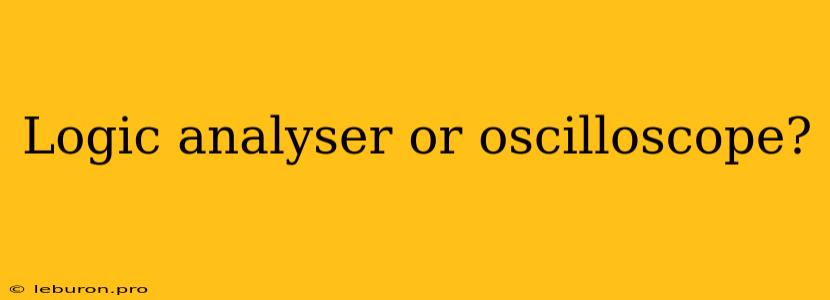Choosing the right tool for your electronic troubleshooting needs can be a daunting task. Two popular options often come to mind: the logic analyzer and the oscilloscope. Both offer unique capabilities, but their strengths lie in different areas, making the choice dependent on the specific application. This article will delve into the functionalities, pros and cons, and use cases of both logic analyzers and oscilloscopes, providing a comprehensive guide to help you determine the best tool for your electronic testing needs.
Logic Analyzer: A Deep Dive into Digital Signals
A logic analyzer is a powerful instrument designed to capture and analyze digital signals, providing a detailed view of the logic states and timing relationships within a digital circuit. It excels at examining the sequence of events and data flow, making it ideal for debugging complex digital systems.
Key Features of a Logic Analyzer:
- Simultaneous Multi-channel Acquisition: Logic analyzers can capture data from multiple channels simultaneously, allowing you to observe the interactions between different signals within a system. This feature is particularly useful for analyzing data busses and understanding the flow of information between different components.
- High-Speed Data Acquisition: Modern logic analyzers can capture data at extremely high speeds, making them suitable for analyzing fast-paced digital systems.
- Powerful Triggering Capabilities: Logic analyzers offer advanced triggering options that allow you to precisely capture the desired data. You can trigger on specific logic state combinations, timing patterns, or data values, ensuring you focus on the most relevant information.
- Detailed Timing Analysis: Logic analyzers provide detailed timing information, allowing you to analyze the precise sequence of events and identify timing issues within a digital circuit.
- Protocol Decoding: Many logic analyzers support protocol decoding, allowing you to interpret the data flowing over common communication buses like I2C, SPI, and UART. This feature simplifies the debugging process by displaying the data in a human-readable format.
Advantages of using a Logic Analyzer:
- Deep Digital Insight: Logic analyzers are unmatched in their ability to provide a detailed view of digital signal behavior, making them excellent for debugging complex digital systems.
- Protocol Decoding: The ability to decode various communication protocols significantly simplifies the analysis of complex digital communication interfaces.
- Triggering for Precise Capture: Advanced triggering capabilities allow you to capture the exact data you need, eliminating the need to sift through large amounts of irrelevant information.
Disadvantages of using a Logic Analyzer:
- Limited Analog Capabilities: Logic analyzers are primarily focused on digital signals and lack the capabilities to analyze analog signals effectively. This limits their usefulness in applications where analog signal behavior is crucial.
- Signal Acquisition Bandwidth: While high-speed logic analyzers exist, their bandwidth is generally lower than oscilloscopes, making them less suitable for analyzing very fast digital signals.
Oscilloscope: Unveiling Analog and Digital Signals
An oscilloscope is a versatile instrument that displays voltage signals over time. It is widely used for analyzing both analog and digital signals, providing a visual representation of the signal's amplitude, frequency, and timing. While logic analyzers excel in analyzing the behavior of digital signals, oscilloscopes are the go-to tool for understanding the characteristics of analog signals.
Key Features of an Oscilloscope:
- Analog Signal Acquisition: Oscilloscopes are designed to capture and analyze analog signals, providing a clear visual representation of the signal's waveform.
- Variable Bandwidth: Oscilloscopes offer a wide range of bandwidths, allowing you to analyze signals with different frequencies. The bandwidth of an oscilloscope determines the highest frequency signal it can accurately capture.
- Triggering and Measurement Functions: Oscilloscopes provide various triggering options to capture specific events within a signal and offer a variety of measurement functions, including frequency, amplitude, and rise time.
- Signal Processing Capabilities: Many oscilloscopes offer advanced signal processing capabilities like FFT analysis, allowing you to analyze the frequency components of a signal.
Advantages of using an Oscilloscope:
- Analog Signal Analysis: Oscilloscopes are the ideal instrument for analyzing analog signals, providing a clear visual representation of the signal's waveform.
- Wide Bandwidth Capabilities: Oscilloscopes offer a much wider bandwidth compared to logic analyzers, making them suitable for analyzing high-frequency signals.
- Versatile Measurement Tools: Oscilloscopes provide a range of measurement functions, making them suitable for analyzing both analog and digital signals.
Disadvantages of using an Oscilloscope:
- Limited Digital Signal Analysis: While oscilloscopes can display digital signals, they lack the advanced capabilities of logic analyzers for analyzing the complex interactions within a digital system.
- Difficulty in Capturing Complex Data Patterns: Oscilloscopes are not as efficient as logic analyzers in capturing and analyzing complex data patterns within digital signals.
When to Choose a Logic Analyzer vs. Oscilloscope
The choice between a logic analyzer and an oscilloscope ultimately depends on the specific needs of your application. Consider the following factors:
- Signal Type: If your application primarily involves digital signals and you need to analyze complex data patterns, a logic analyzer is a better choice. However, for applications with analog signals, an oscilloscope is the preferred tool.
- Signal Speed: If your application involves very high-frequency signals, an oscilloscope with a wide bandwidth is essential. For slower digital signals, a logic analyzer can be sufficient.
- Triggering Capabilities: If you need to capture specific events within a signal, consider the triggering options available on both instruments.
- Data Acquisition Capabilities: Consider the number of channels and the data acquisition speed of each instrument to ensure they meet the requirements of your application.
Conclusion
Both logic analyzers and oscilloscopes are essential tools for electronic troubleshooting. The choice between the two depends on the specific requirements of your application. Logic analyzers excel in analyzing digital signals, providing detailed information on data flow and timing relationships. Oscilloscopes, on the other hand, are ideal for analyzing analog signals and offer a clear visual representation of the signal's waveform. By carefully considering the features and capabilities of each instrument, you can select the best tool for your electronic testing needs and gain deeper insights into the behavior of your circuits.
